Comprehensive Report on Developing Effective Organization Policies
VerifiedAdded on 2024/06/07
|20
|3858
|93
Report
AI Summary
This assignment solution comprehensively addresses the development of organizational policies, covering various aspects such as identifying the scope of a policy, analyzing issues, drafting new policies, and understanding the policy cycle. It delves into minimizing organizational risk through analytical frameworks, examining the influence of existing policies and laws, and identifying internal and external factors that trigger policy changes. The solution further includes an analysis of risks associated with poor policy planning and a detailed examination of factors influencing policy changes within Fountain Art, including stakeholder consultations and iterative processes. The assignment also outlines a policy development process, analyzing risks, defining policy requirements, and gathering information from stakeholders, considering legal, ethical, and practical aspects. Finally, it involves developing policy options and outlining communication and implementation strategies, ensuring a thorough understanding of policy development in organizational settings. Desklib provides access to this and many other solved assignments.
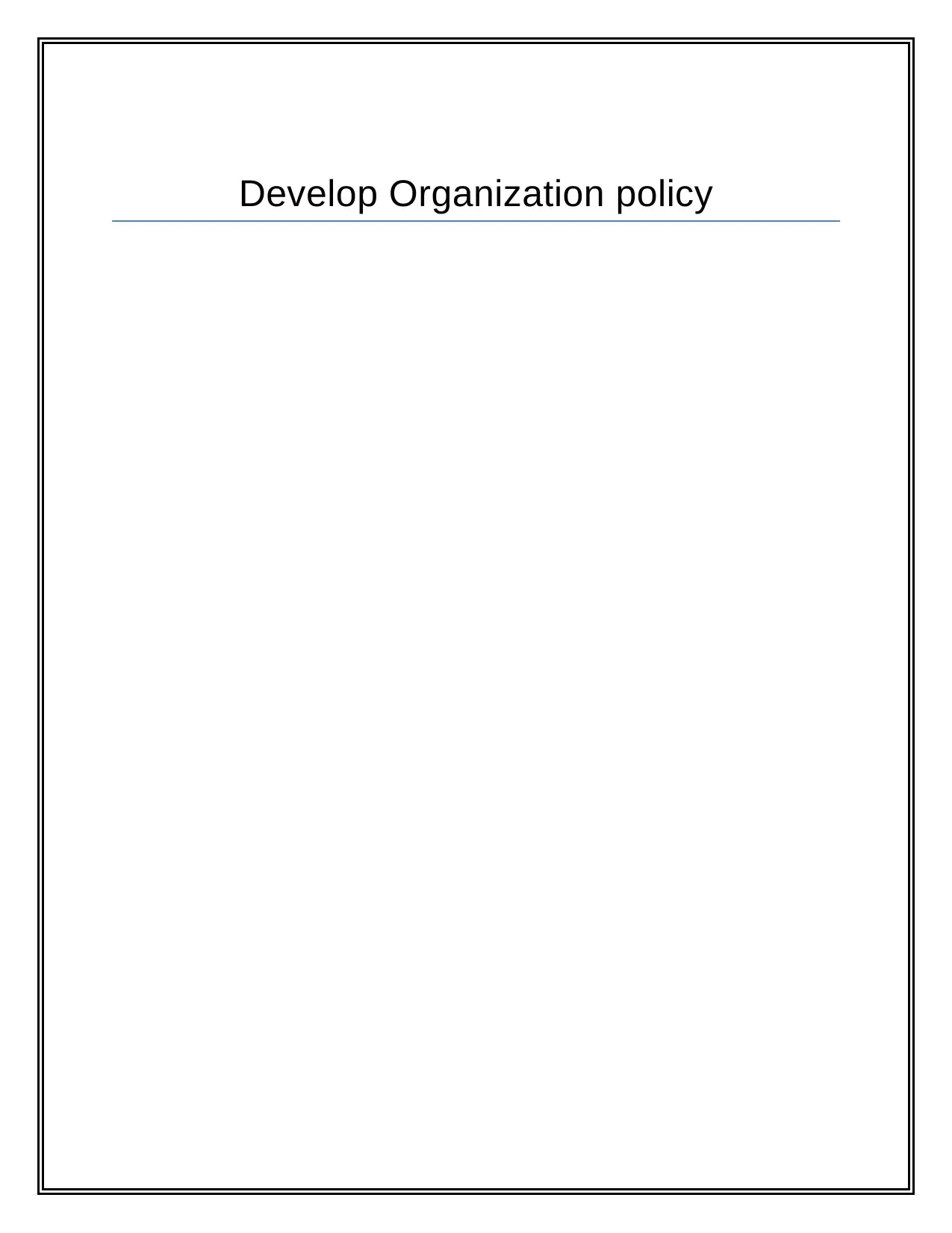
Develop Organization policy
Paraphrase This Document
Need a fresh take? Get an instant paraphrase of this document with our AI Paraphraser
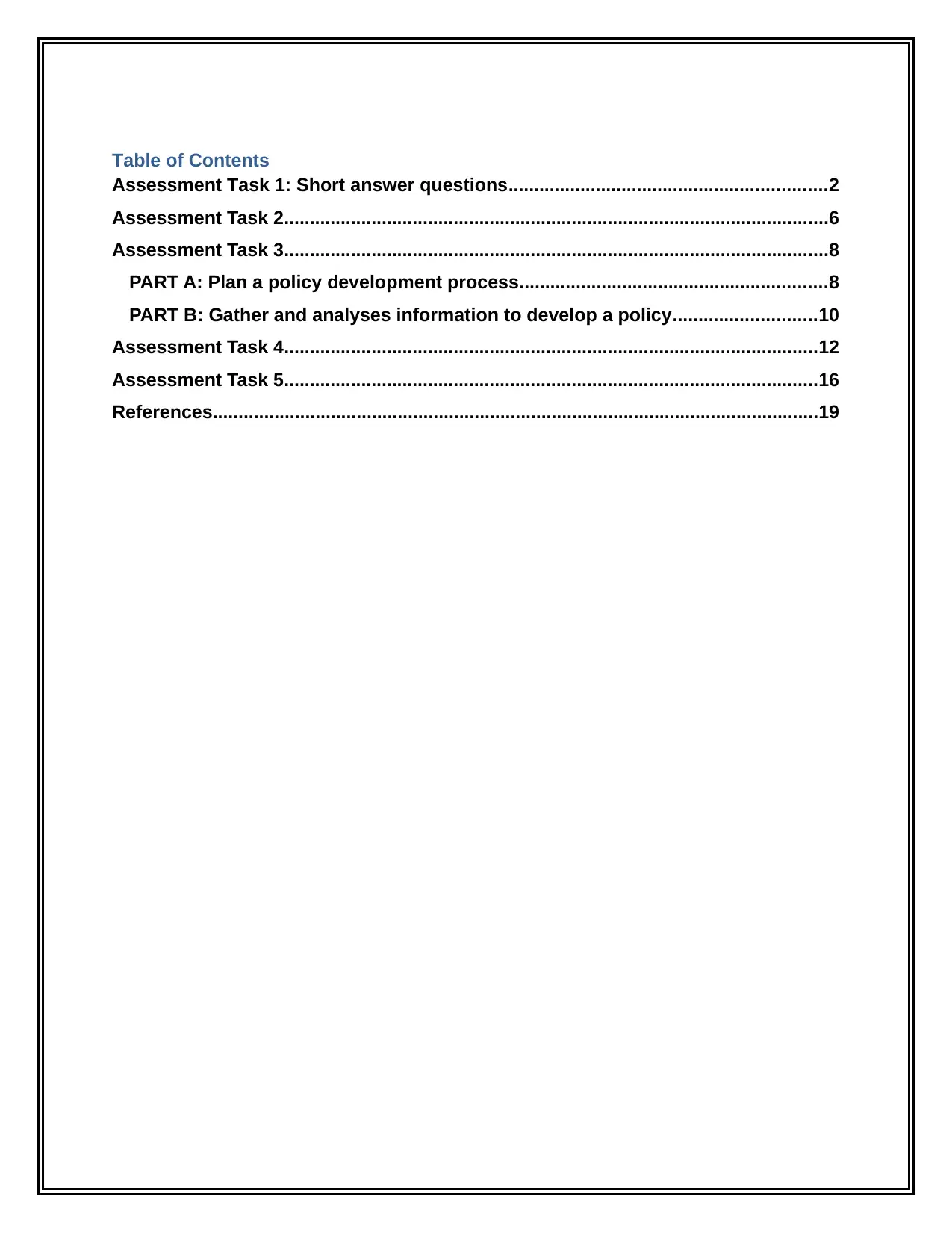
Table of Contents
Assessment Task 1: Short answer questions..............................................................2
Assessment Task 2..........................................................................................................6
Assessment Task 3..........................................................................................................8
PART A: Plan a policy development process............................................................8
PART B: Gather and analyses information to develop a policy............................10
Assessment Task 4........................................................................................................12
Assessment Task 5........................................................................................................16
References......................................................................................................................19
Assessment Task 1: Short answer questions..............................................................2
Assessment Task 2..........................................................................................................6
Assessment Task 3..........................................................................................................8
PART A: Plan a policy development process............................................................8
PART B: Gather and analyses information to develop a policy............................10
Assessment Task 4........................................................................................................12
Assessment Task 5........................................................................................................16
References......................................................................................................................19
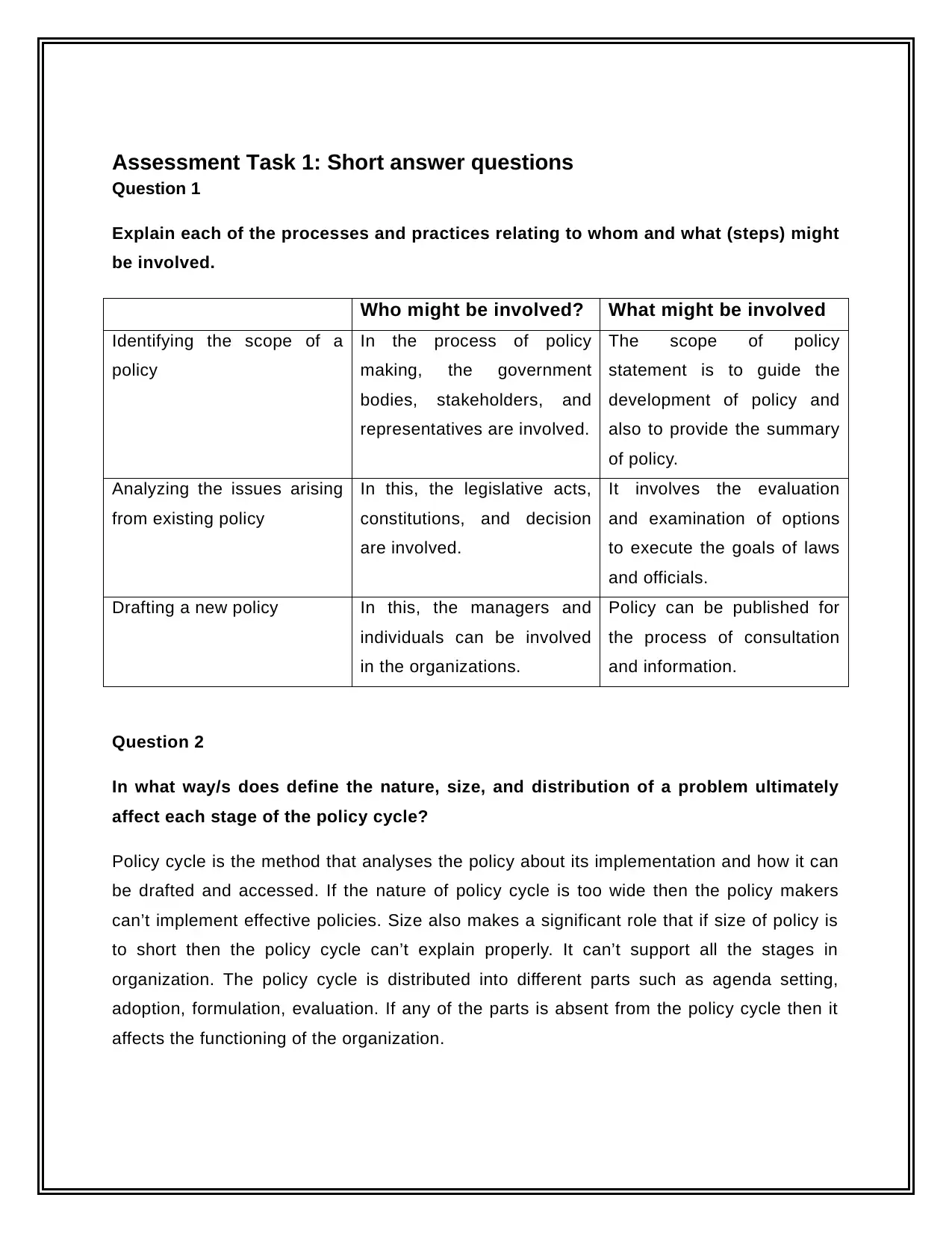
Assessment Task 1: Short answer questions
Question 1
Explain each of the processes and practices relating to whom and what (steps) might
be involved.
Who might be involved? What might be involved
Identifying the scope of a
policy
In the process of policy
making, the government
bodies, stakeholders, and
representatives are involved.
The scope of policy
statement is to guide the
development of policy and
also to provide the summary
of policy.
Analyzing the issues arising
from existing policy
In this, the legislative acts,
constitutions, and decision
are involved.
It involves the evaluation
and examination of options
to execute the goals of laws
and officials.
Drafting a new policy In this, the managers and
individuals can be involved
in the organizations.
Policy can be published for
the process of consultation
and information.
Question 2
In what way/s does define the nature, size, and distribution of a problem ultimately
affect each stage of the policy cycle?
Policy cycle is the method that analyses the policy about its implementation and how it can
be drafted and accessed. If the nature of policy cycle is too wide then the policy makers
can’t implement effective policies. Size also makes a significant role that if size of policy is
to short then the policy cycle can’t explain properly. It can’t support all the stages in
organization. The policy cycle is distributed into different parts such as agenda setting,
adoption, formulation, evaluation. If any of the parts is absent from the policy cycle then it
affects the functioning of the organization.
Question 1
Explain each of the processes and practices relating to whom and what (steps) might
be involved.
Who might be involved? What might be involved
Identifying the scope of a
policy
In the process of policy
making, the government
bodies, stakeholders, and
representatives are involved.
The scope of policy
statement is to guide the
development of policy and
also to provide the summary
of policy.
Analyzing the issues arising
from existing policy
In this, the legislative acts,
constitutions, and decision
are involved.
It involves the evaluation
and examination of options
to execute the goals of laws
and officials.
Drafting a new policy In this, the managers and
individuals can be involved
in the organizations.
Policy can be published for
the process of consultation
and information.
Question 2
In what way/s does define the nature, size, and distribution of a problem ultimately
affect each stage of the policy cycle?
Policy cycle is the method that analyses the policy about its implementation and how it can
be drafted and accessed. If the nature of policy cycle is too wide then the policy makers
can’t implement effective policies. Size also makes a significant role that if size of policy is
to short then the policy cycle can’t explain properly. It can’t support all the stages in
organization. The policy cycle is distributed into different parts such as agenda setting,
adoption, formulation, evaluation. If any of the parts is absent from the policy cycle then it
affects the functioning of the organization.
⊘ This is a preview!⊘
Do you want full access?
Subscribe today to unlock all pages.

Trusted by 1+ million students worldwide
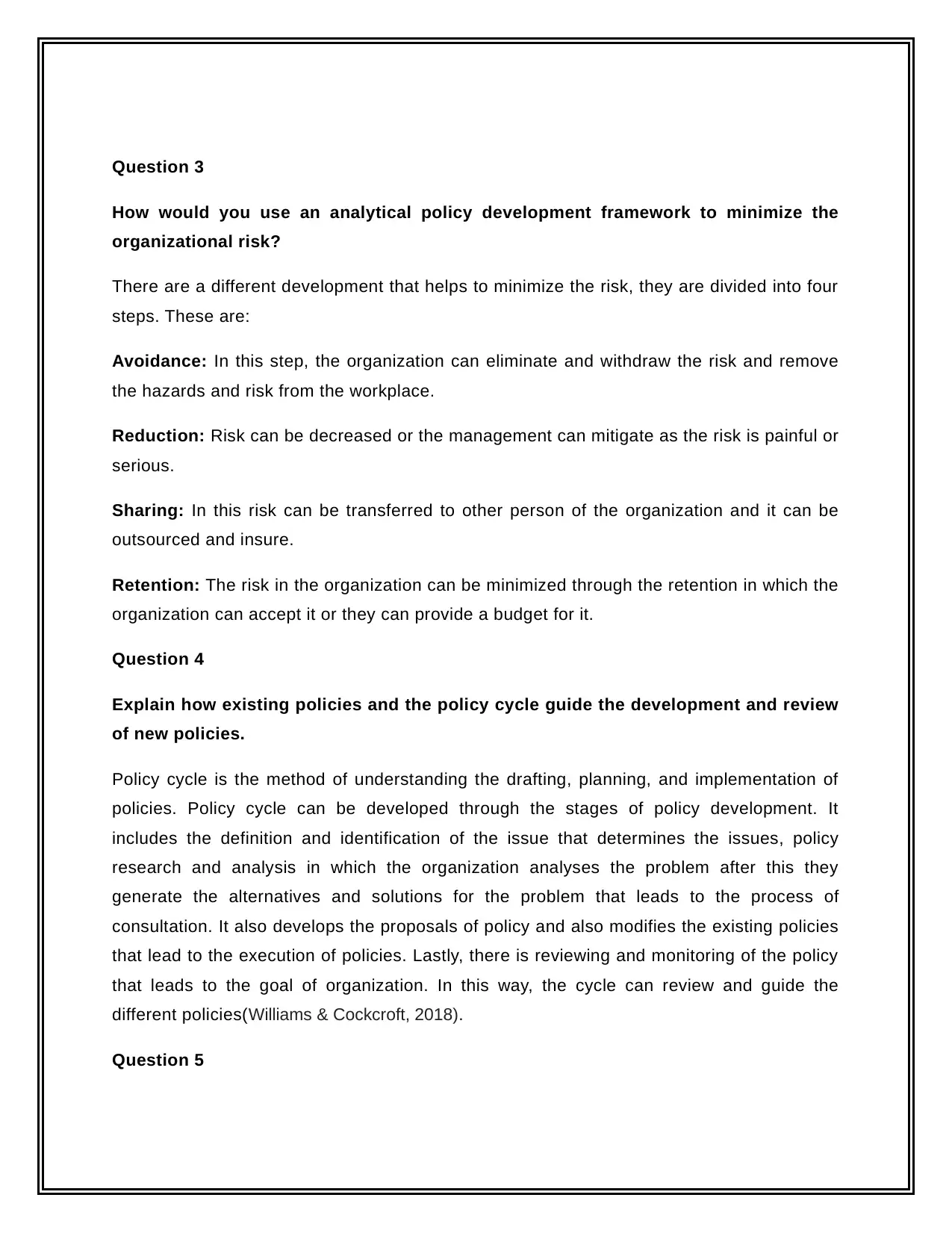
Question 3
How would you use an analytical policy development framework to minimize the
organizational risk?
There are a different development that helps to minimize the risk, they are divided into four
steps. These are:
Avoidance: In this step, the organization can eliminate and withdraw the risk and remove
the hazards and risk from the workplace.
Reduction: Risk can be decreased or the management can mitigate as the risk is painful or
serious.
Sharing: In this risk can be transferred to other person of the organization and it can be
outsourced and insure.
Retention: The risk in the organization can be minimized through the retention in which the
organization can accept it or they can provide a budget for it.
Question 4
Explain how existing policies and the policy cycle guide the development and review
of new policies.
Policy cycle is the method of understanding the drafting, planning, and implementation of
policies. Policy cycle can be developed through the stages of policy development. It
includes the definition and identification of the issue that determines the issues, policy
research and analysis in which the organization analyses the problem after this they
generate the alternatives and solutions for the problem that leads to the process of
consultation. It also develops the proposals of policy and also modifies the existing policies
that lead to the execution of policies. Lastly, there is reviewing and monitoring of the policy
that leads to the goal of organization. In this way, the cycle can review and guide the
different policies(Williams & Cockcroft, 2018).
Question 5
How would you use an analytical policy development framework to minimize the
organizational risk?
There are a different development that helps to minimize the risk, they are divided into four
steps. These are:
Avoidance: In this step, the organization can eliminate and withdraw the risk and remove
the hazards and risk from the workplace.
Reduction: Risk can be decreased or the management can mitigate as the risk is painful or
serious.
Sharing: In this risk can be transferred to other person of the organization and it can be
outsourced and insure.
Retention: The risk in the organization can be minimized through the retention in which the
organization can accept it or they can provide a budget for it.
Question 4
Explain how existing policies and the policy cycle guide the development and review
of new policies.
Policy cycle is the method of understanding the drafting, planning, and implementation of
policies. Policy cycle can be developed through the stages of policy development. It
includes the definition and identification of the issue that determines the issues, policy
research and analysis in which the organization analyses the problem after this they
generate the alternatives and solutions for the problem that leads to the process of
consultation. It also develops the proposals of policy and also modifies the existing policies
that lead to the execution of policies. Lastly, there is reviewing and monitoring of the policy
that leads to the goal of organization. In this way, the cycle can review and guide the
different policies(Williams & Cockcroft, 2018).
Question 5
Paraphrase This Document
Need a fresh take? Get an instant paraphrase of this document with our AI Paraphraser
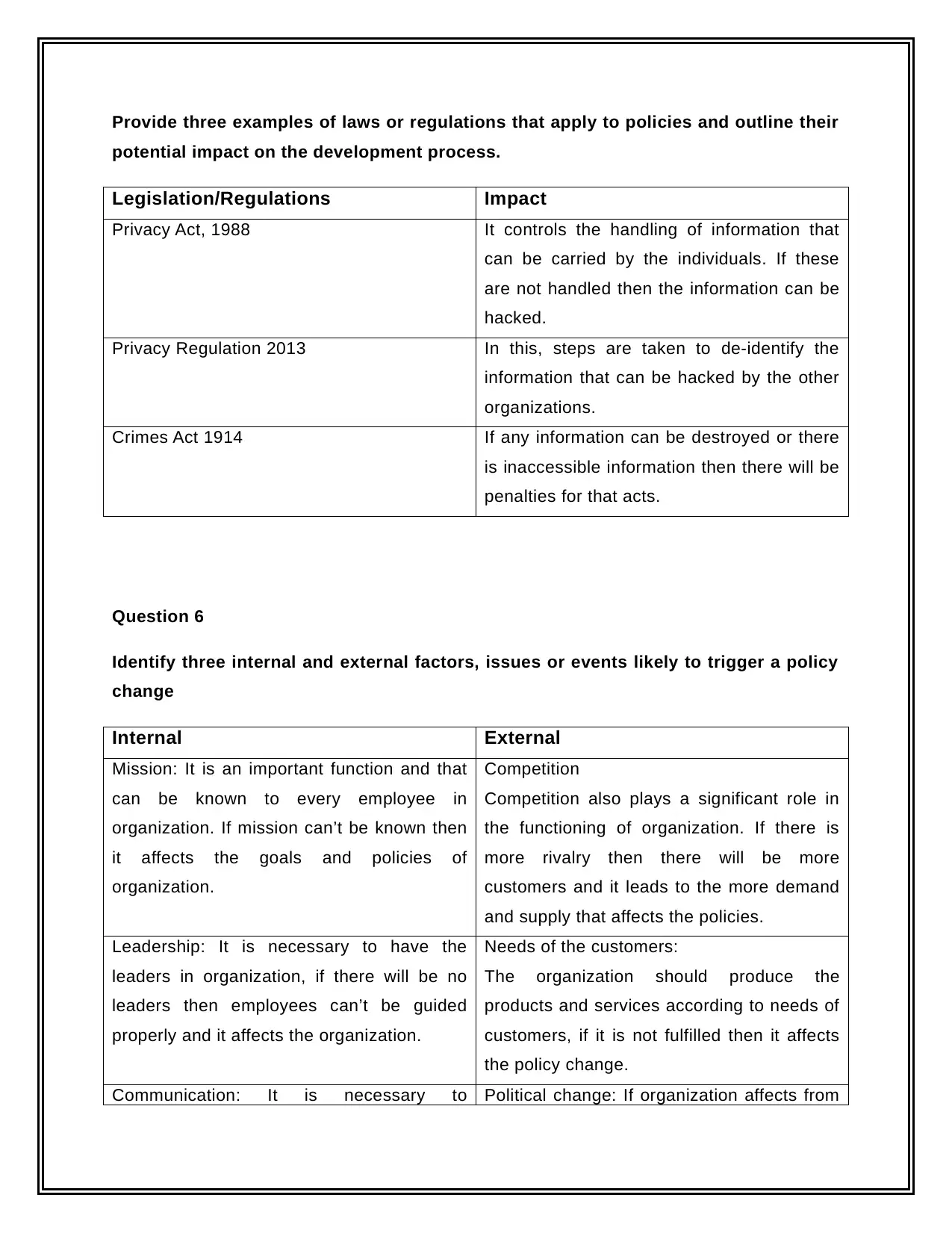
Provide three examples of laws or regulations that apply to policies and outline their
potential impact on the development process.
Legislation/Regulations Impact
Privacy Act, 1988 It controls the handling of information that
can be carried by the individuals. If these
are not handled then the information can be
hacked.
Privacy Regulation 2013 In this, steps are taken to de-identify the
information that can be hacked by the other
organizations.
Crimes Act 1914 If any information can be destroyed or there
is inaccessible information then there will be
penalties for that acts.
Question 6
Identify three internal and external factors, issues or events likely to trigger a policy
change
Internal External
Mission: It is an important function and that
can be known to every employee in
organization. If mission can’t be known then
it affects the goals and policies of
organization.
Competition
Competition also plays a significant role in
the functioning of organization. If there is
more rivalry then there will be more
customers and it leads to the more demand
and supply that affects the policies.
Leadership: It is necessary to have the
leaders in organization, if there will be no
leaders then employees can’t be guided
properly and it affects the organization.
Needs of the customers:
The organization should produce the
products and services according to needs of
customers, if it is not fulfilled then it affects
the policy change.
Communication: It is necessary to Political change: If organization affects from
potential impact on the development process.
Legislation/Regulations Impact
Privacy Act, 1988 It controls the handling of information that
can be carried by the individuals. If these
are not handled then the information can be
hacked.
Privacy Regulation 2013 In this, steps are taken to de-identify the
information that can be hacked by the other
organizations.
Crimes Act 1914 If any information can be destroyed or there
is inaccessible information then there will be
penalties for that acts.
Question 6
Identify three internal and external factors, issues or events likely to trigger a policy
change
Internal External
Mission: It is an important function and that
can be known to every employee in
organization. If mission can’t be known then
it affects the goals and policies of
organization.
Competition
Competition also plays a significant role in
the functioning of organization. If there is
more rivalry then there will be more
customers and it leads to the more demand
and supply that affects the policies.
Leadership: It is necessary to have the
leaders in organization, if there will be no
leaders then employees can’t be guided
properly and it affects the organization.
Needs of the customers:
The organization should produce the
products and services according to needs of
customers, if it is not fulfilled then it affects
the policy change.
Communication: It is necessary to Political change: If organization affects from
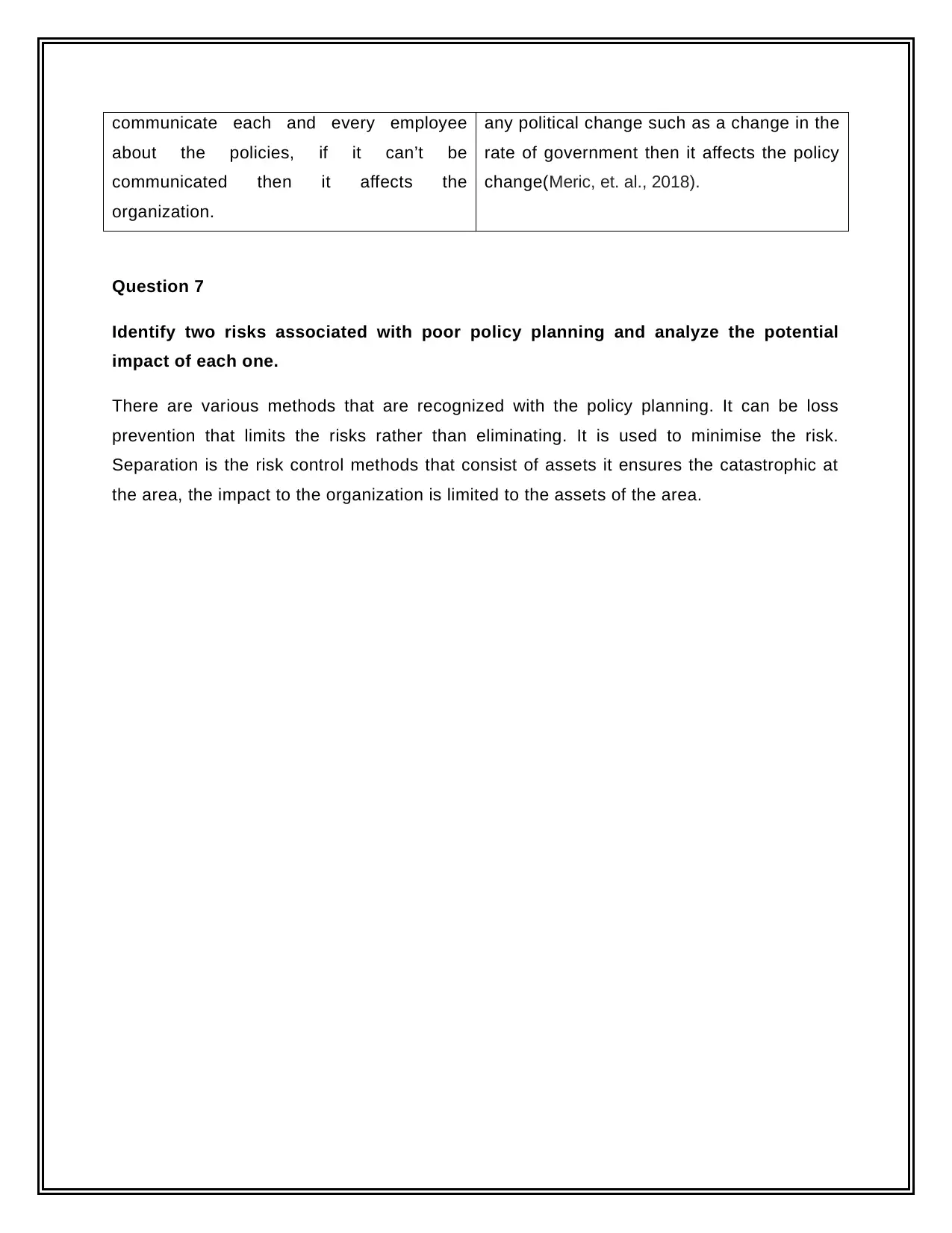
communicate each and every employee
about the policies, if it can’t be
communicated then it affects the
organization.
any political change such as a change in the
rate of government then it affects the policy
change(Meric, et. al., 2018).
Question 7
Identify two risks associated with poor policy planning and analyze the potential
impact of each one.
There are various methods that are recognized with the policy planning. It can be loss
prevention that limits the risks rather than eliminating. It is used to minimise the risk.
Separation is the risk control methods that consist of assets it ensures the catastrophic at
the area, the impact to the organization is limited to the assets of the area.
about the policies, if it can’t be
communicated then it affects the
organization.
any political change such as a change in the
rate of government then it affects the policy
change(Meric, et. al., 2018).
Question 7
Identify two risks associated with poor policy planning and analyze the potential
impact of each one.
There are various methods that are recognized with the policy planning. It can be loss
prevention that limits the risks rather than eliminating. It is used to minimise the risk.
Separation is the risk control methods that consist of assets it ensures the catastrophic at
the area, the impact to the organization is limited to the assets of the area.
⊘ This is a preview!⊘
Do you want full access?
Subscribe today to unlock all pages.

Trusted by 1+ million students worldwide
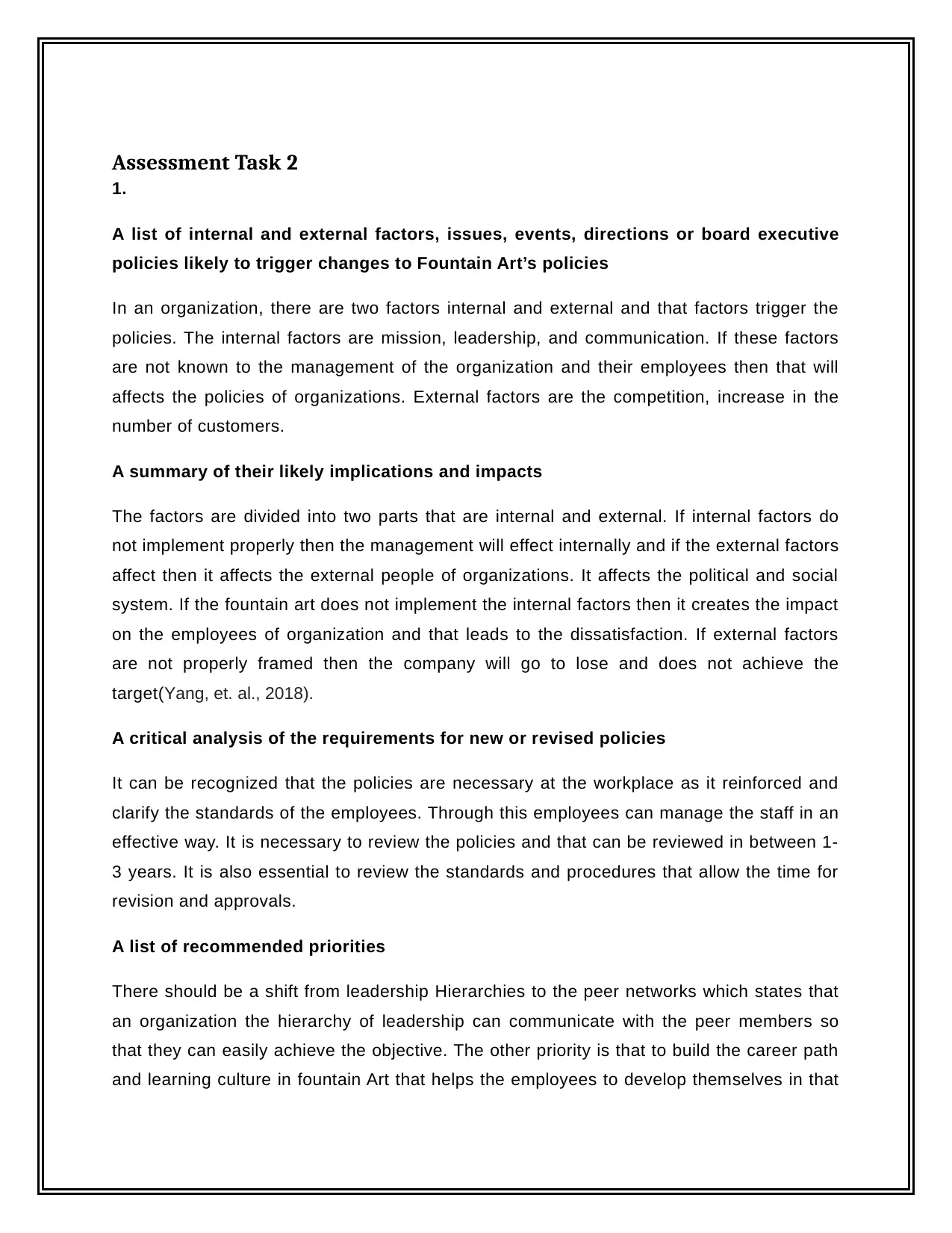
Assessment Task 2
1.
A list of internal and external factors, issues, events, directions or board executive
policies likely to trigger changes to Fountain Art’s policies
In an organization, there are two factors internal and external and that factors trigger the
policies. The internal factors are mission, leadership, and communication. If these factors
are not known to the management of the organization and their employees then that will
affects the policies of organizations. External factors are the competition, increase in the
number of customers.
A summary of their likely implications and impacts
The factors are divided into two parts that are internal and external. If internal factors do
not implement properly then the management will effect internally and if the external factors
affect then it affects the external people of organizations. It affects the political and social
system. If the fountain art does not implement the internal factors then it creates the impact
on the employees of organization and that leads to the dissatisfaction. If external factors
are not properly framed then the company will go to lose and does not achieve the
target(Yang, et. al., 2018).
A critical analysis of the requirements for new or revised policies
It can be recognized that the policies are necessary at the workplace as it reinforced and
clarify the standards of the employees. Through this employees can manage the staff in an
effective way. It is necessary to review the policies and that can be reviewed in between 1-
3 years. It is also essential to review the standards and procedures that allow the time for
revision and approvals.
A list of recommended priorities
There should be a shift from leadership Hierarchies to the peer networks which states that
an organization the hierarchy of leadership can communicate with the peer members so
that they can easily achieve the objective. The other priority is that to build the career path
and learning culture in fountain Art that helps the employees to develop themselves in that
1.
A list of internal and external factors, issues, events, directions or board executive
policies likely to trigger changes to Fountain Art’s policies
In an organization, there are two factors internal and external and that factors trigger the
policies. The internal factors are mission, leadership, and communication. If these factors
are not known to the management of the organization and their employees then that will
affects the policies of organizations. External factors are the competition, increase in the
number of customers.
A summary of their likely implications and impacts
The factors are divided into two parts that are internal and external. If internal factors do
not implement properly then the management will effect internally and if the external factors
affect then it affects the external people of organizations. It affects the political and social
system. If the fountain art does not implement the internal factors then it creates the impact
on the employees of organization and that leads to the dissatisfaction. If external factors
are not properly framed then the company will go to lose and does not achieve the
target(Yang, et. al., 2018).
A critical analysis of the requirements for new or revised policies
It can be recognized that the policies are necessary at the workplace as it reinforced and
clarify the standards of the employees. Through this employees can manage the staff in an
effective way. It is necessary to review the policies and that can be reviewed in between 1-
3 years. It is also essential to review the standards and procedures that allow the time for
revision and approvals.
A list of recommended priorities
There should be a shift from leadership Hierarchies to the peer networks which states that
an organization the hierarchy of leadership can communicate with the peer members so
that they can easily achieve the objective. The other priority is that to build the career path
and learning culture in fountain Art that helps the employees to develop themselves in that
Paraphrase This Document
Need a fresh take? Get an instant paraphrase of this document with our AI Paraphraser
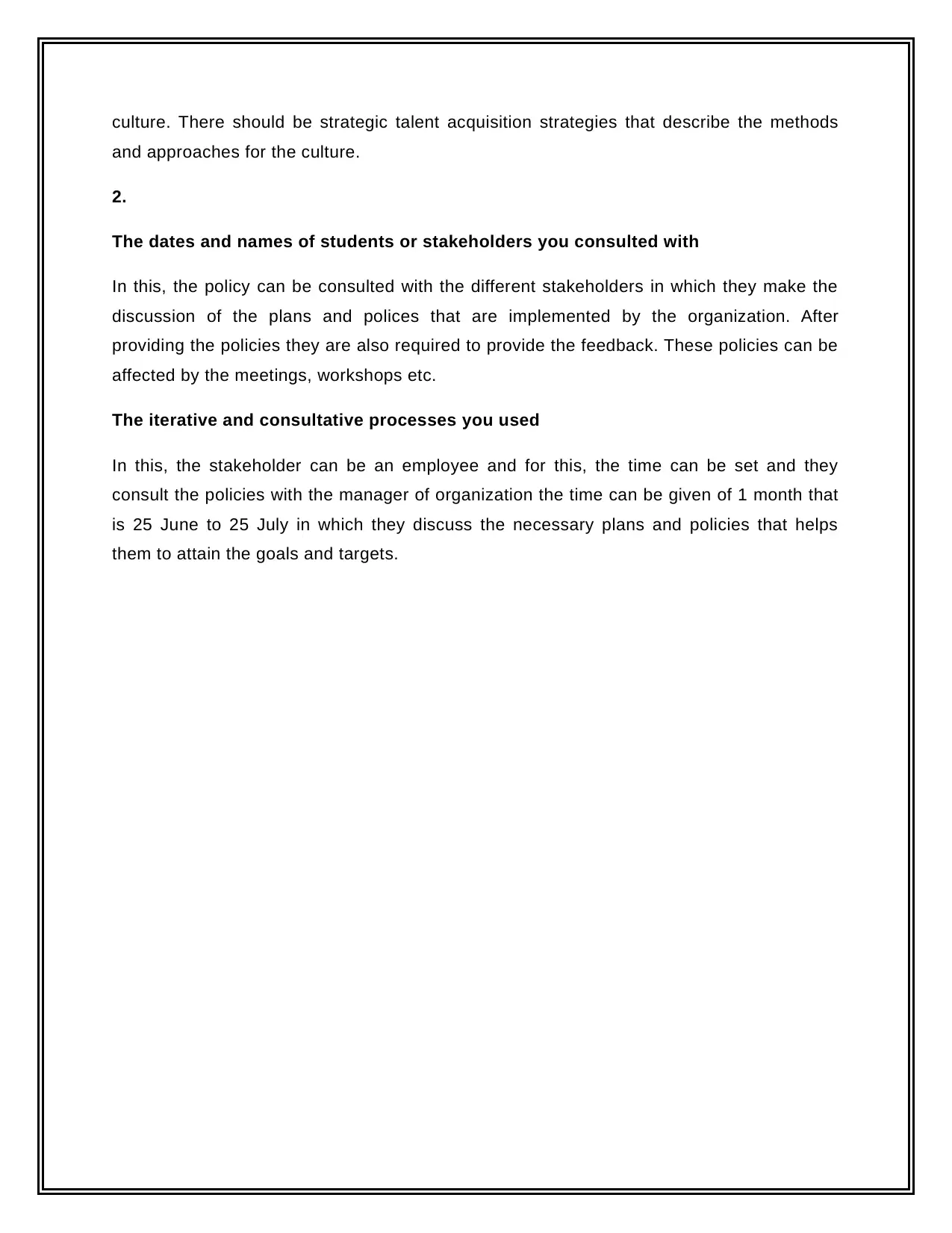
culture. There should be strategic talent acquisition strategies that describe the methods
and approaches for the culture.
2.
The dates and names of students or stakeholders you consulted with
In this, the policy can be consulted with the different stakeholders in which they make the
discussion of the plans and polices that are implemented by the organization. After
providing the policies they are also required to provide the feedback. These policies can be
affected by the meetings, workshops etc.
The iterative and consultative processes you used
In this, the stakeholder can be an employee and for this, the time can be set and they
consult the policies with the manager of organization the time can be given of 1 month that
is 25 June to 25 July in which they discuss the necessary plans and policies that helps
them to attain the goals and targets.
and approaches for the culture.
2.
The dates and names of students or stakeholders you consulted with
In this, the policy can be consulted with the different stakeholders in which they make the
discussion of the plans and polices that are implemented by the organization. After
providing the policies they are also required to provide the feedback. These policies can be
affected by the meetings, workshops etc.
The iterative and consultative processes you used
In this, the stakeholder can be an employee and for this, the time can be set and they
consult the policies with the manager of organization the time can be given of 1 month that
is 25 June to 25 July in which they discuss the necessary plans and policies that helps
them to attain the goals and targets.
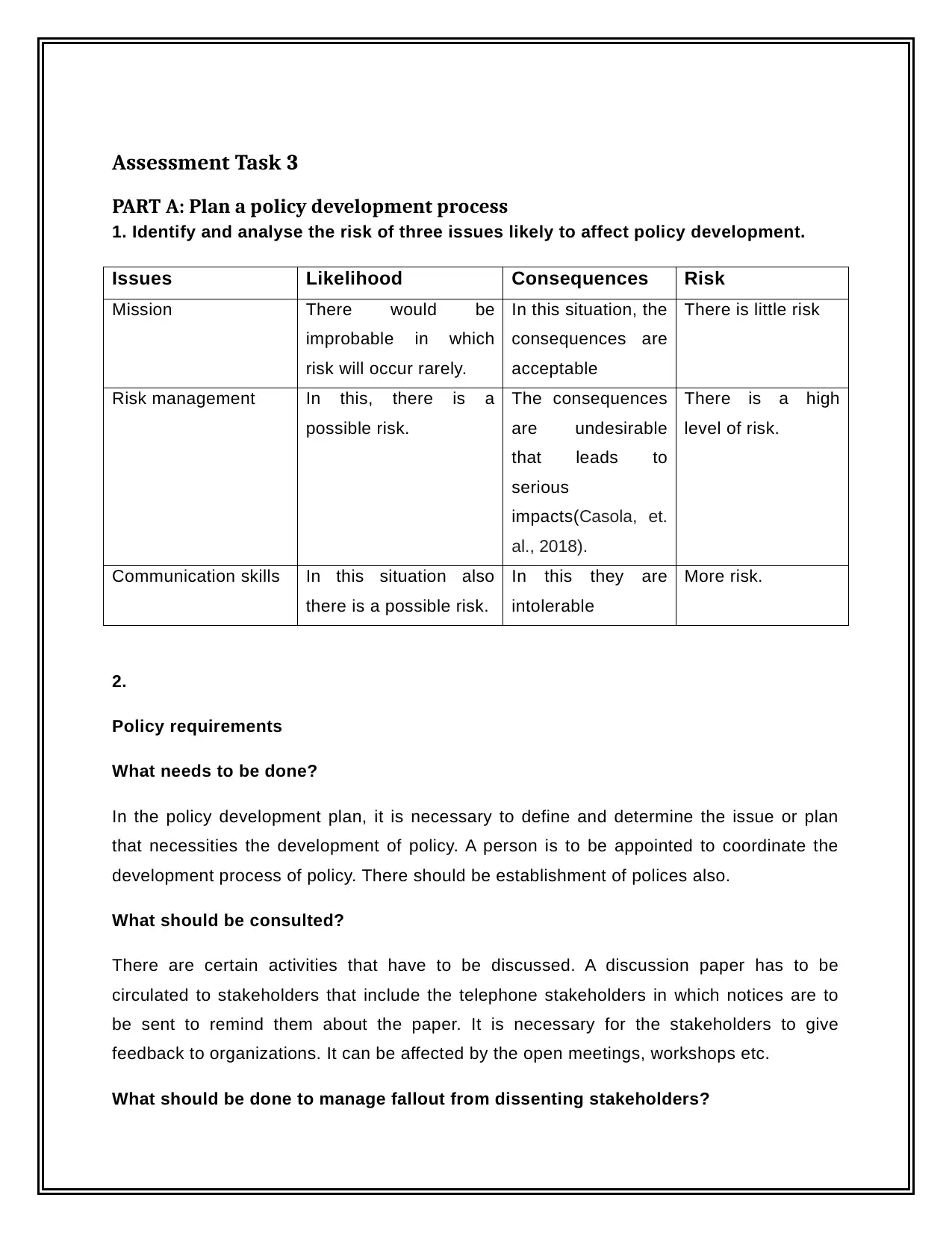
Assessment Task 3
PART A: Plan a policy development process
1. Identify and analyse the risk of three issues likely to affect policy development.
Issues Likelihood Consequences Risk
Mission There would be
improbable in which
risk will occur rarely.
In this situation, the
consequences are
acceptable
There is little risk
Risk management In this, there is a
possible risk.
The consequences
are undesirable
that leads to
serious
impacts(Casola, et.
al., 2018).
There is a high
level of risk.
Communication skills In this situation also
there is a possible risk.
In this they are
intolerable
More risk.
2.
Policy requirements
What needs to be done?
In the policy development plan, it is necessary to define and determine the issue or plan
that necessities the development of policy. A person is to be appointed to coordinate the
development process of policy. There should be establishment of polices also.
What should be consulted?
There are certain activities that have to be discussed. A discussion paper has to be
circulated to stakeholders that include the telephone stakeholders in which notices are to
be sent to remind them about the paper. It is necessary for the stakeholders to give
feedback to organizations. It can be affected by the open meetings, workshops etc.
What should be done to manage fallout from dissenting stakeholders?
PART A: Plan a policy development process
1. Identify and analyse the risk of three issues likely to affect policy development.
Issues Likelihood Consequences Risk
Mission There would be
improbable in which
risk will occur rarely.
In this situation, the
consequences are
acceptable
There is little risk
Risk management In this, there is a
possible risk.
The consequences
are undesirable
that leads to
serious
impacts(Casola, et.
al., 2018).
There is a high
level of risk.
Communication skills In this situation also
there is a possible risk.
In this they are
intolerable
More risk.
2.
Policy requirements
What needs to be done?
In the policy development plan, it is necessary to define and determine the issue or plan
that necessities the development of policy. A person is to be appointed to coordinate the
development process of policy. There should be establishment of polices also.
What should be consulted?
There are certain activities that have to be discussed. A discussion paper has to be
circulated to stakeholders that include the telephone stakeholders in which notices are to
be sent to remind them about the paper. It is necessary for the stakeholders to give
feedback to organizations. It can be affected by the open meetings, workshops etc.
What should be done to manage fallout from dissenting stakeholders?
⊘ This is a preview!⊘
Do you want full access?
Subscribe today to unlock all pages.

Trusted by 1+ million students worldwide
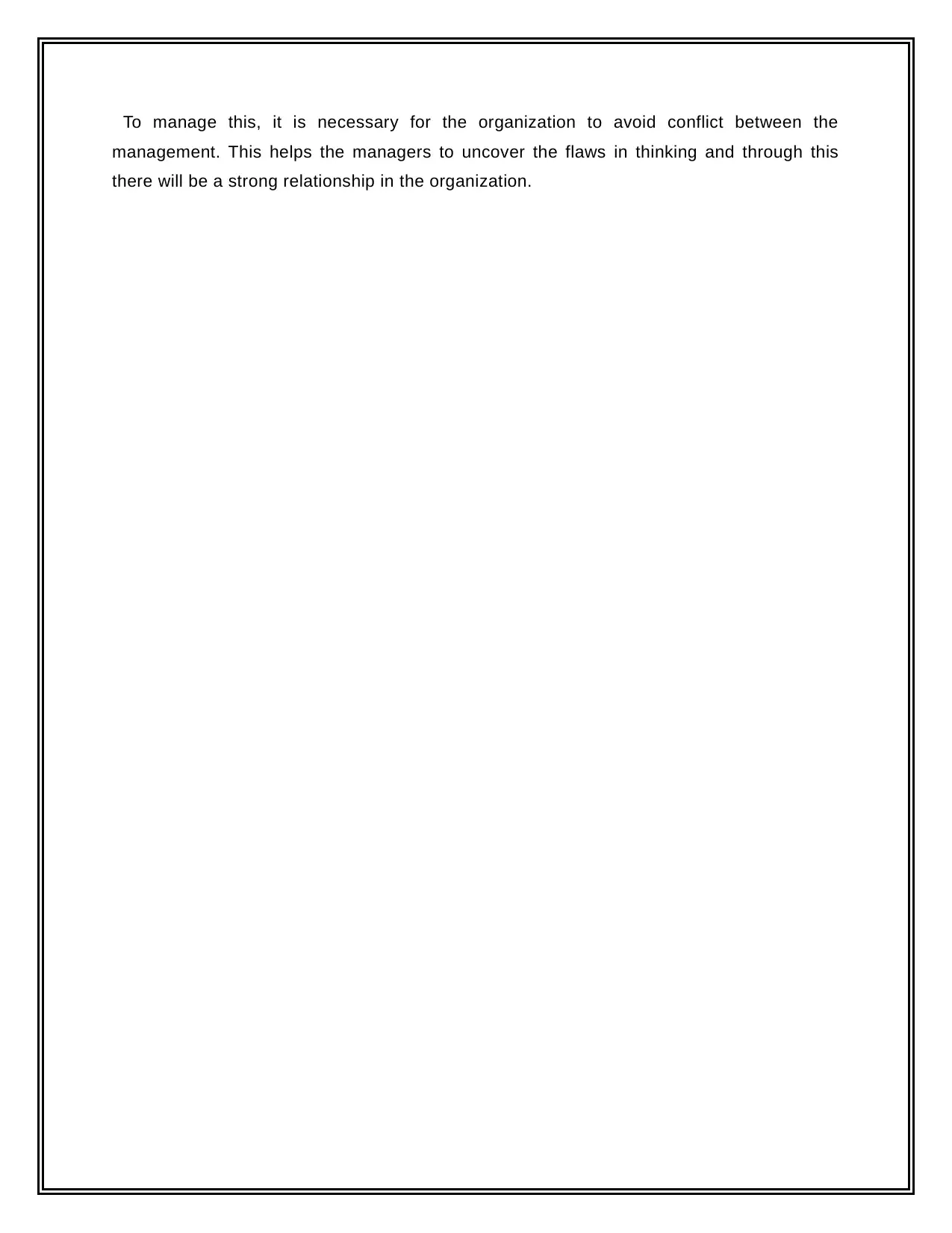
To manage this, it is necessary for the organization to avoid conflict between the
management. This helps the managers to uncover the flaws in thinking and through this
there will be a strong relationship in the organization.
management. This helps the managers to uncover the flaws in thinking and through this
there will be a strong relationship in the organization.
Paraphrase This Document
Need a fresh take? Get an instant paraphrase of this document with our AI Paraphraser
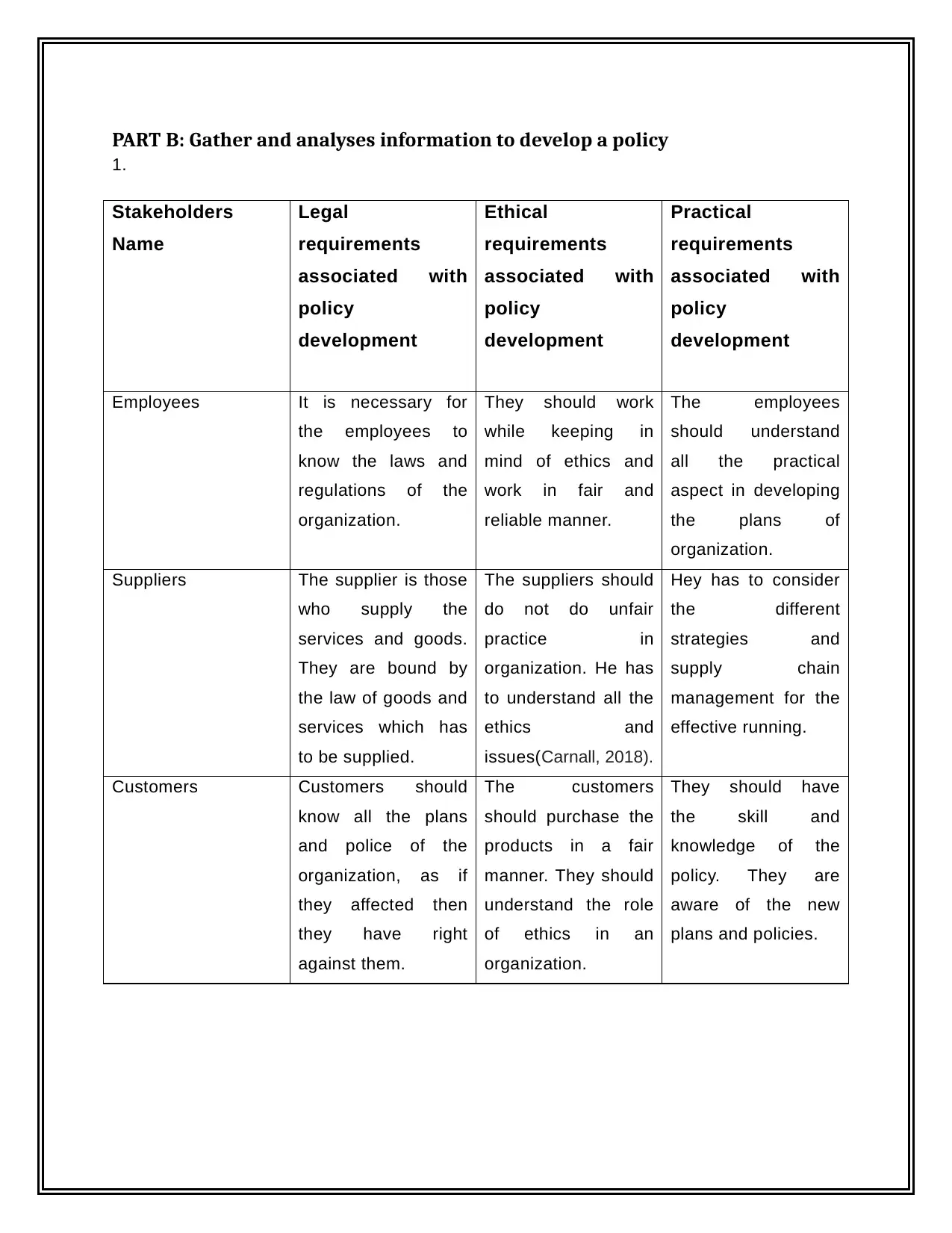
PART B: Gather and analyses information to develop a policy
1.
Stakeholders
Name
Legal
requirements
associated with
policy
development
Ethical
requirements
associated with
policy
development
Practical
requirements
associated with
policy
development
Employees It is necessary for
the employees to
know the laws and
regulations of the
organization.
They should work
while keeping in
mind of ethics and
work in fair and
reliable manner.
The employees
should understand
all the practical
aspect in developing
the plans of
organization.
Suppliers The supplier is those
who supply the
services and goods.
They are bound by
the law of goods and
services which has
to be supplied.
The suppliers should
do not do unfair
practice in
organization. He has
to understand all the
ethics and
issues(Carnall, 2018).
Hey has to consider
the different
strategies and
supply chain
management for the
effective running.
Customers Customers should
know all the plans
and police of the
organization, as if
they affected then
they have right
against them.
The customers
should purchase the
products in a fair
manner. They should
understand the role
of ethics in an
organization.
They should have
the skill and
knowledge of the
policy. They are
aware of the new
plans and policies.
1.
Stakeholders
Name
Legal
requirements
associated with
policy
development
Ethical
requirements
associated with
policy
development
Practical
requirements
associated with
policy
development
Employees It is necessary for
the employees to
know the laws and
regulations of the
organization.
They should work
while keeping in
mind of ethics and
work in fair and
reliable manner.
The employees
should understand
all the practical
aspect in developing
the plans of
organization.
Suppliers The supplier is those
who supply the
services and goods.
They are bound by
the law of goods and
services which has
to be supplied.
The suppliers should
do not do unfair
practice in
organization. He has
to understand all the
ethics and
issues(Carnall, 2018).
Hey has to consider
the different
strategies and
supply chain
management for the
effective running.
Customers Customers should
know all the plans
and police of the
organization, as if
they affected then
they have right
against them.
The customers
should purchase the
products in a fair
manner. They should
understand the role
of ethics in an
organization.
They should have
the skill and
knowledge of the
policy. They are
aware of the new
plans and policies.
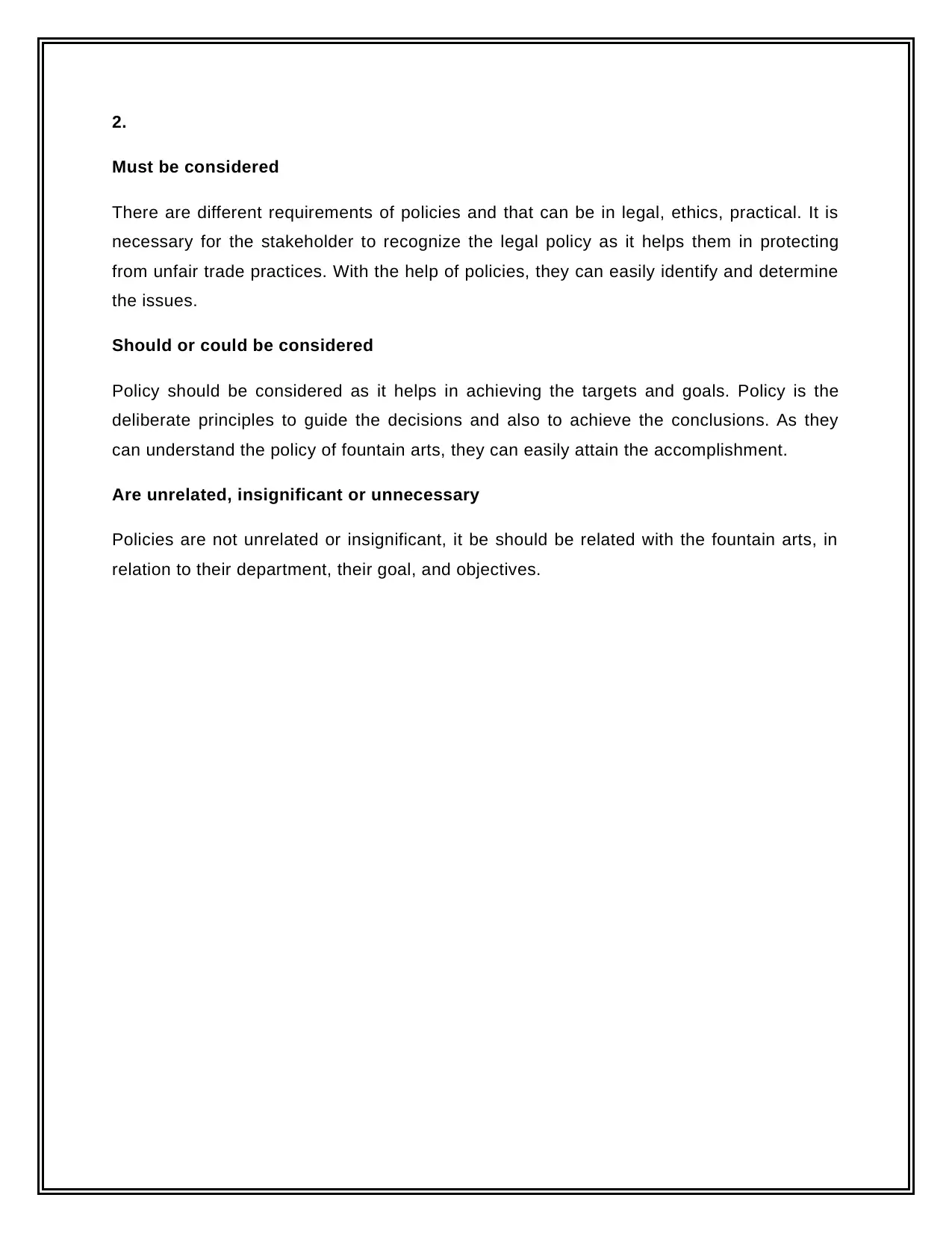
2.
Must be considered
There are different requirements of policies and that can be in legal, ethics, practical. It is
necessary for the stakeholder to recognize the legal policy as it helps them in protecting
from unfair trade practices. With the help of policies, they can easily identify and determine
the issues.
Should or could be considered
Policy should be considered as it helps in achieving the targets and goals. Policy is the
deliberate principles to guide the decisions and also to achieve the conclusions. As they
can understand the policy of fountain arts, they can easily attain the accomplishment.
Are unrelated, insignificant or unnecessary
Policies are not unrelated or insignificant, it be should be related with the fountain arts, in
relation to their department, their goal, and objectives.
Must be considered
There are different requirements of policies and that can be in legal, ethics, practical. It is
necessary for the stakeholder to recognize the legal policy as it helps them in protecting
from unfair trade practices. With the help of policies, they can easily identify and determine
the issues.
Should or could be considered
Policy should be considered as it helps in achieving the targets and goals. Policy is the
deliberate principles to guide the decisions and also to achieve the conclusions. As they
can understand the policy of fountain arts, they can easily attain the accomplishment.
Are unrelated, insignificant or unnecessary
Policies are not unrelated or insignificant, it be should be related with the fountain arts, in
relation to their department, their goal, and objectives.
⊘ This is a preview!⊘
Do you want full access?
Subscribe today to unlock all pages.

Trusted by 1+ million students worldwide
1 out of 20
Related Documents
Your All-in-One AI-Powered Toolkit for Academic Success.
+13062052269
info@desklib.com
Available 24*7 on WhatsApp / Email
![[object Object]](/_next/static/media/star-bottom.7253800d.svg)
Unlock your academic potential
Copyright © 2020–2025 A2Z Services. All Rights Reserved. Developed and managed by ZUCOL.




